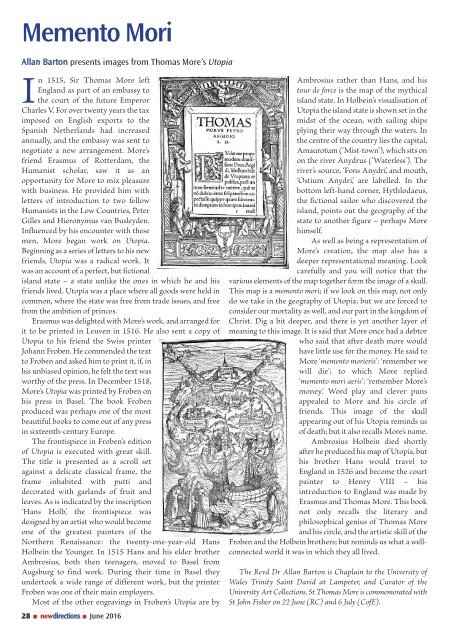parish directory
55F5maAIR
55F5maAIR
Create successful ePaper yourself
Turn your PDF publications into a flip-book with our unique Google optimized e-Paper software.
Memento Mori<br />
Allan Barton presents images from Thomas More’s Utopia<br />
In 1515, Sir Thomas More left<br />
England as part of an embassy to<br />
the court of the future Emperor<br />
Charles V. For over twenty years the tax<br />
imposed on English exports to the<br />
Spanish Netherlands had increased<br />
annually, and the embassy was sent to<br />
negotiate a new arrangement. More’s<br />
friend Erasmus of Rotterdam, the<br />
Humanist scholar, saw it as an<br />
opportunity for More to mix pleasure<br />
with business. He provided him with<br />
letters of introduction to two fellow<br />
Humanists in the Low Countries, Peter<br />
Gilles and Hieronymus van Busleyden.<br />
Influenced by his encounter with these<br />
men, More began work on Utopia.<br />
Beginning as a series of letters to his new<br />
friends, Utopia was a radical work. It<br />
was an account of a perfect, but fictional<br />
island state – a state unlike the ones in which he and his<br />
friends lived. Utopia was a place where all goods were held in<br />
common, where the state was free from trade issues, and free<br />
from the ambition of princes.<br />
Erasmus was delighted with More’s work, and arranged for<br />
it to be printed in Leuven in 1516. He also sent a copy of<br />
Utopia to his friend the Swiss printer<br />
Johann Froben. He commended the text<br />
to Froben and asked him to print it, if, in<br />
his unbiased opinion, he felt the text was<br />
worthy of the press. In December 1518,<br />
More’s Utopia was printed by Froben on<br />
his press in Basel. The book Froben<br />
produced was perhaps one of the most<br />
beautiful books to come out of any press<br />
in sixteenth-century Europe.<br />
The frontispiece in Froben’s edition<br />
of Utopia is executed with great skill.<br />
The title is presented as a scroll set<br />
against a delicate classical frame, the<br />
frame inhabited with putti and<br />
decorated with garlands of fruit and<br />
leaves. As is indicated by the inscription<br />
‘Hans Holb’, the frontispiece was<br />
designed by an artist who would become<br />
one of the greatest painters of the<br />
Northern Renaissance: the twenty-one-year-old Hans<br />
Holbein the Younger. In 1515 Hans and his elder brother<br />
Ambrosius, both then teenagers, moved to Basel from<br />
Augsburg to find work. During their time in Basel they<br />
undertook a wide range of different work, but the printer<br />
Froben was one of their main employers.<br />
Most of the other engravings in Froben’s Utopia are by<br />
28 ■ newdirections ■ June 2016<br />
Ambrosius rather than Hans, and his<br />
tour de force is the map of the mythical<br />
island state. In Holbein’s visualisation of<br />
Utopia the island state is shown set in the<br />
midst of the ocean, with sailing ships<br />
plying their way through the waters. In<br />
the centre of the country lies the capital,<br />
Amaurotum (‘Mist-town’), which sits on<br />
on the river Anydrus (‘Waterless’). The<br />
river’s source, ‘Fons Anydri’, and mouth,<br />
‘Ostium Anydri’, are labelled. In the<br />
bottom left-hand corner, Hythlodaeus,<br />
the fictional sailor who discovered the<br />
island, points out the geography of the<br />
state to another figure – perhaps More<br />
himself.<br />
As well as being a representation of<br />
More’s creation, the map also has a<br />
deeper representational meaning. Look<br />
carefully and you will notice that the<br />
various elements of the map together form the image of a skull.<br />
This map is a memento mori; if we look on this map, not only<br />
do we take in the geography of Utopia; but we are forced to<br />
consider our mortality as well, and our part in the kingdom of<br />
Christ. Dig a bit deeper, and there is yet another layer of<br />
meaning to this image. It is said that More once had a debtor<br />
who said that after death more would<br />
have little use for the money. He said to<br />
More ‘memento morieris’: ‘remember we<br />
will die’; to which More replied<br />
‘memento mori aeris’: ‘remember More’s<br />
money’. Word play and clever puns<br />
appealed to More and his circle of<br />
friends. This image of the skull<br />
appearing out of his Utopia reminds us<br />
of death; but it also recalls More’s name.<br />
Ambrosius Holbein died shortly<br />
after he produced his map of Utopia, but<br />
his brother Hans would travel to<br />
England in 1526 and become the court<br />
painter to Henry VIII – his<br />
introduction to England was made by<br />
Erasmus and Thomas More. This book<br />
not only recalls the literary and<br />
philosophical genius of Thomas More<br />
and his circle, and the artistic skill of the<br />
Froben and the Holbein brothers; but reminds us what a wellconnected<br />
world it was in which they all lived.<br />
The Revd Dr Allan Barton is Chaplain to the University of<br />
Wales Trinity Saint David at Lampeter, and Curator of the<br />
University Art Collections. St Thomas More is commemorated with<br />
St John Fisher on 22 June (RC) and 6 July (CofE).


